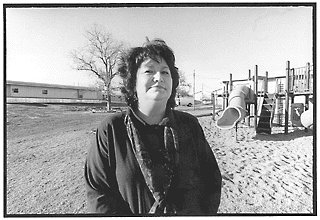The Growth Word
Schoolhouse Rock and a Hard Place
By Roseana Auten, Fri., Dec. 12, 1997
|
|
If you weren't informed of it, the aroma of prepubescent sweat would surely give it away. One of Kiker Elementary School's 22 portable buildings is used as a "satellite" gymnasium -- for tumbling, aerobic activity, and even bowling -- so that all of its 1,212 students can get in a little physical education. Located inside the swanky Circle C Ranch housing development off Slaughter Lane in Southwest Austin, Kiker was only built for 675 students, but has been over-enrolled since it opened in 1992 -- a situation that, as rumor had it, prompted a cabal of parents to lobby for "Circle C residents only" status for the school a few years ago. They weren't successful -- hundreds of students from other developing neighborhoods are still bussed into the school. About seven or eight miles east of Circle C in the Village South neighborhood, just east of I-35 and north of Stassney Lane, Houston Elementary School is also dealing with overcrowding -- 1,029 students are enrolled, whereas the school was built in 1976 to hold 720 students. Fourteen portables are on that site to hold the burgeoning population. In this school's attendance zone, however, no new houses are going up, and there is certainly no air of exclusivity to the area. It is simply a diverse neighborhood, now in transition. "There's no reason to believe that we would be getting more kids every year, but that's what's happening," says Houston principal Sarah Nelson.
Help is on the way, though. Both the southwest and southeast sectors of the Austin Independent School District (AISD) are slated to receive new, or so-called "relief," schools under the 1996 $369 million bond package to help alleviate the crowding. Eleven schools in all are to be built, with the lion's share going in the southern regions of AISD. Four schools -- three elementaries and a middle school -- are to be built in the southwest. Two -- an elementary and a middle school -- are going up in the southeast. A new high school will be located south of Ben White Boulevard (and away from environmentally sensitive areas). AISD has either broken ground, selected sites, or identified areas for site selection for these seven schools south of Town Lake. (This includes the controversial decision to locate a middle school on the environmentally sensitive recharge zone of the Edwards Aquifer.)
But south-dwelling parents and neighborhood activists say those schools won't furnish enough relief. A final, southern elementary school -- which was identified for voters as a "south central" school -- has yet to be sited. But everyone is calling dibs on it. Southwest residents feel that the body count calls for the last "south" school to go to their area. Southeast residents feel the same way, except their position is bolstered by environmentalists' claims that more southwest schools would encourage development away from Austin's preferred growth corridor. Meanwhile, AISD officials have hunkered back down on the whole question, and are attempting to redefine what is really meant by "south central," "southwest," and "southeast."
It's more than a matter of semantics, though. It's a matter of integrity -- and all concerned say AISD board members must face it. Trouble first flared last month, when the AISD Board of Trustees held a Nov. 17 public hearing on proposed areas for four relief schools, including the high school and two elementary schools to be located in North Austin. But lo and behold the so-called "south central" school had somehow been nebulously redefined as just a "south" school. And two areas that could certainly be considered southwest, and one area that was inarguably southeast, were offered up under the new rubric.
To further complicate matters, the outside demographer hired by AISD, Dennis Harner, seemed to confirm some long-held suspicions that AISD is in fact planning for future growth in the city's far-flung zones. Speaking on one of the proposed relief areas in the southwest, which is located on land the district currently owns in Travis Country, Harner told the board, "There will be growth in that area and there may be need for a school in the planning time that we're talking about." To some, this ran counter to AISD's long-held position that all new schools were going to be erected to hold children already in the district, not to accommodate anticipated growth.
Ah ha! We always knew it! cried environmental activists. What happened to the "south central' designation? other members of the public demanded to know. The board of trustees is required to have a public hearing if it's going to change anything that voters have approved, others pointed out. Pick the southeast! No, pick a southwest area! chimed others.
The following week, during the November 24 regular meeting of the AISD board, deputy superintendent for administrative support services A.C. Gonzalez explained to the board that a planning sector map the district currently uses is confusing -- contrary to expectations, the "southwest" zone, for example, actually runs catty-wampus between AISD's west and east borders in a long, wide strip at the southernmost bottom of the school district. Gonzalez reminded the board that both the south school (as well as the non-controversial north school) were always intended to be sort of "swing" schools, and to be sited and constructed once all the other elementary schools were situated. As such, the last south elementary site (and the north site) didn't actually need to be chosen until 1999. Gonzalez recommended to the board that staff be given time to draw a new planning sector map -- one that would be less confusing to all concerned -- and to delay the designation of the final relief areas for several months. Board members concurred, but with the caveat that a public hearing on this be held in January, since this could represent a change from the election order that went before voters in April 1996. "We need to have truth in advertising," says Kathy Rider, AISD board president.
But the issue of whether AISD is planning buildings for anticipated growth has not been publicly resolved. Rider says that the district staff's use of the word "growth" during the recent meetings is unfortunate. "I don't have a clue why they used the `growth' word," she says. "This is not a `growth' bond." Rider stressed that schools are being built based on numbers of live births in the area, and on the number of children already enrolled in the district, not on future land development. She thinks that because many key AISD staffers have less than five years' tenure, they do not realize that they must be more precise with their terminology, and "this is an extra-sensitive issue." Rider says she plans to ask staff to make this more clear when the matter of "growth" comes up again.
But the various stakeholders say they're not appeased by any of this. "The board has to decide whether they're going to be a follower or a leader in the development of the city," says Jeff Jack, president of the Austin Neighborhoods Council and a member of the AISD Citizens' Bond Oversight Committee. He thinks that contrary to what district officials may say, the placement of schools does affect development. He says that bussing from neighborhoods east of Kiker is a major factor in the overpopulation of the campus, and that crowding there can be best relieved not by building more schools there, but by building schools east, which would draw people more toward preferred growth areas.
And at least one parent from the southwest agrees with Jack. "While my children attended Kiker, classes were constantly interrupted by the principal escorting real estate persons and their clients through the school," the parent wrote in a letter to AISD trustees earlier this year. But this parent's point of view is probably exceptional, as it is primarily parent representatives who are leading the charge to build in the southwest. "Build the schools, and build them now," says Olga Garza, president of the Kiker PTA. "The commitment was made that schools should be built where the kids are."
"Our biggest fear is that the school board will take the line of the environmentalists and not do anything in this area," says Darrell Whatley, president of the Boone Elementary School PTA (and no relation to AISD Board member Ted Whatley). Boone, in the southwest, is in fact going to get an eight-classroom addition under the bond package, but Whatley fears it won't be sufficient to ameliorate crowding at the school. "Nothing would make me happier than to see them stop building in the southwest, but that would mean that the city would have to stop issuing permits," he says.
Some board members privately believe that neither side -- not irate parents, nor charged-up environmentalists -- wants to be confused with facts that don't converge with their agendas. But in spite of their high-pitched rhetoric, both sides say they don't want to see the debate degenerate into a battle over territory, but to do what's best for all concerned. Rider is all for that. She says she'd be willing to have town meetings on the issue so people can ask questions and get answers they can understand -- "because we're not working together as well as we could at this point."
Got something to say on the subject? Send a letter to the editor.







